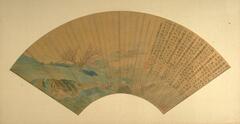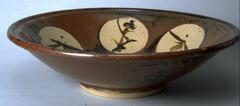10 Items in this Learning Collection
Collection Object
Collection Object
Collection Object
Collection Object
Collection Object
Collection Object
Collection Object
Collection Object
Collection Object
Collection Object
Copyright
All Rights Reserved
()
White celadon bowl with incised diamond pattern
Accession Number
1963/2.68
Title
White celadon bowl with incised diamond pattern
Artist(s)
Katō Takuo
Object Creation Date
circa 1960
Medium & Support
Porcelain with white celadon glaze
Dimensions
11 in x 14 15/16 in x 15 ¼ in (27.94 cm x 37.94 cm x 38.74 cm);11 in x 14 15/16 in x 15 ¼ in (27.94 cm x 37.94 cm x 38.74 cm)
Credit Line
Museum Purchase
Label copy
Katô Takuo
Japan, 1917–2005
White celadon bowl
Showa period, 1926–1989
circa 1960
Porcelain with white celadon glaze
Gift of the artist, 1963/2.65
Katô Takuo complemented the austere look of this large bowl with a series of stamped lozenge patterns. Although the bowl is intended for display, the artist took inspiration from the utilitarian design aesthetic of Finland, where he studied as a young man.
Born into a family of flourishing potters in the ceramic center of Mino, Katô mastered many techniques under the tutelage of his father, Katô Kôbei (1893–1982). Like his father, he produced diverse types of works, including the Shino ware flask-shaped bottle displayed elsewhere in this exhibition. He later became known for his meticulous reproductions of ancient and near-lost techniques such as Japanese sancai (tricolor) glazed wares from the eighth century and the lusterware originally created in eleventh to thirteenth century Persia (modern day Iran).
(label for Turning Point show at UMMA)
Katô Takuo complemented the austere look of this large bowl with a series of stamped lozenge patterns. Although the bowl is intended for display, the artist took inspiration from the utilitarian design aesthetics of Finland, where he studied as young man.
Born into a family of flourishing potters in the ceramic center of Mino, Katô mastered many ceramic techniques under the tutelage of his father, Katô Kôkei (1893–1982). He later became known for his meticulous reproduction of sancai (tricolor) glazed wares stored in Shôsôin, the eighth-century repository of the Imperial Court.
(Label for UMMA Japanese Gallery Opening Rotation, March 2009)
--
Katô Takuo complemented the austere look of this large bowl with a series of stamped lozenge patterns. Although the bowl is intended for display, the artist took inspiration from the utilitarian design aesthetic of Finland, where he studied as a young man.
Born into a family of flourishing potters in the ceramic center of Mino, Katô mastered many techniques under the tutelage of his father, Katô Kôbei (1893–1982). Like his father, he produced diverse types of works, including the Shino ware flask-shaped bottle displayed elsewhere in this exhibition. He later became known for his meticulous reproductions of ancient and near-lost techniques such as Japanese sancai (tricolor) glazed wares from the eighth century and the lusterware originally created in eleventh to thirteenth century Persia (modern day Iran).
(Turning Point exhibition, Spring 2010)
Subject matter
White bowl with diamond patterns
Physical Description
The large white bowl is round with a wide rim and a narrow bottom; almost like an up-side-down cone shape. Diamond patterns are stamped around the middle of the body. It has no foot. The rim is slightly warped.
Primary Object Classification
Ceramic
Primary Object Type
bowl
Additional Object Classification(s)
Decorative Arts
Collection Area
Asian
Rights
If you are interested in using an image for a publication, please visit http://umma.umich.edu/request-image for more information and to fill out the online Image Rights and Reproductions Request Form.
Keywords
bowls (vessels)
geometric patterns
lozenges
1963/2.68
Title
White celadon bowl with incised diamond pattern
Artist(s)
Katō Takuo
Object Creation Date
circa 1960
Medium & Support
Porcelain with white celadon glaze
Dimensions
11 in x 14 15/16 in x 15 ¼ in (27.94 cm x 37.94 cm x 38.74 cm);11 in x 14 15/16 in x 15 ¼ in (27.94 cm x 37.94 cm x 38.74 cm)
Credit Line
Museum Purchase
Label copy
Katô Takuo
Japan, 1917–2005
White celadon bowl
Showa period, 1926–1989
circa 1960
Porcelain with white celadon glaze
Gift of the artist, 1963/2.65
Katô Takuo complemented the austere look of this large bowl with a series of stamped lozenge patterns. Although the bowl is intended for display, the artist took inspiration from the utilitarian design aesthetic of Finland, where he studied as a young man.
Born into a family of flourishing potters in the ceramic center of Mino, Katô mastered many techniques under the tutelage of his father, Katô Kôbei (1893–1982). Like his father, he produced diverse types of works, including the Shino ware flask-shaped bottle displayed elsewhere in this exhibition. He later became known for his meticulous reproductions of ancient and near-lost techniques such as Japanese sancai (tricolor) glazed wares from the eighth century and the lusterware originally created in eleventh to thirteenth century Persia (modern day Iran).
(label for Turning Point show at UMMA)
Katô Takuo complemented the austere look of this large bowl with a series of stamped lozenge patterns. Although the bowl is intended for display, the artist took inspiration from the utilitarian design aesthetics of Finland, where he studied as young man.
Born into a family of flourishing potters in the ceramic center of Mino, Katô mastered many ceramic techniques under the tutelage of his father, Katô Kôkei (1893–1982). He later became known for his meticulous reproduction of sancai (tricolor) glazed wares stored in Shôsôin, the eighth-century repository of the Imperial Court.
(Label for UMMA Japanese Gallery Opening Rotation, March 2009)
--
Katô Takuo complemented the austere look of this large bowl with a series of stamped lozenge patterns. Although the bowl is intended for display, the artist took inspiration from the utilitarian design aesthetic of Finland, where he studied as a young man.
Born into a family of flourishing potters in the ceramic center of Mino, Katô mastered many techniques under the tutelage of his father, Katô Kôbei (1893–1982). Like his father, he produced diverse types of works, including the Shino ware flask-shaped bottle displayed elsewhere in this exhibition. He later became known for his meticulous reproductions of ancient and near-lost techniques such as Japanese sancai (tricolor) glazed wares from the eighth century and the lusterware originally created in eleventh to thirteenth century Persia (modern day Iran).
(Turning Point exhibition, Spring 2010)
Subject matter
White bowl with diamond patterns
Physical Description
The large white bowl is round with a wide rim and a narrow bottom; almost like an up-side-down cone shape. Diamond patterns are stamped around the middle of the body. It has no foot. The rim is slightly warped.
Primary Object Classification
Ceramic
Primary Object Type
bowl
Additional Object Classification(s)
Decorative Arts
Collection Area
Asian
Rights
If you are interested in using an image for a publication, please visit http://umma.umich.edu/request-image for more information and to fill out the online Image Rights and Reproductions Request Form.
Keywords
bowls (vessels)
geometric patterns
lozenges










